by Billy Lin
語言:
English ///中文
Translation: Aaron Wytze Wilson
Photo Credit: Liberty Times
New Bloom would like to thank Initium Media (端傳媒) for its permission to republish Billy Lin’s piece in English.
SINCE PRESIDENT Tsai Ing-wen (蔡英文) took office on May 20th, she has time and again vowed to become “the President most able to communicate with the public.” But by looking at a recent flurry of controversies, a number of problems have emerged regarding the administration’s ability to communicate.
The recent amendment to Taiwan’s Labor Standards Act is a good example. When formulating the so-called “one fixed day off, one flexible rest day” policy, the government met continuously with owners of private capital, and modified policy content to meet the demands of private capital. But Tsai did not accept any demands from labor groups requesting the government retain the previous “seven day vacation” stipulation, triggering discontent among the public.
Another example is the recent pension reform meetings. Although the organizers opened up a live video feed during the meetings, there was no list of demands from stakeholders prepared in advance, nor was any information made available to the public to help the public better understand the meetings. Even worse, there were no channels made available for the public to put forward ideas to influence the agenda. In the end, this kind of “citizen participation” is simply for show, with no substantial way to incorporate the public’s views. People can only watch as meeting participants fight it out over a live video feed.
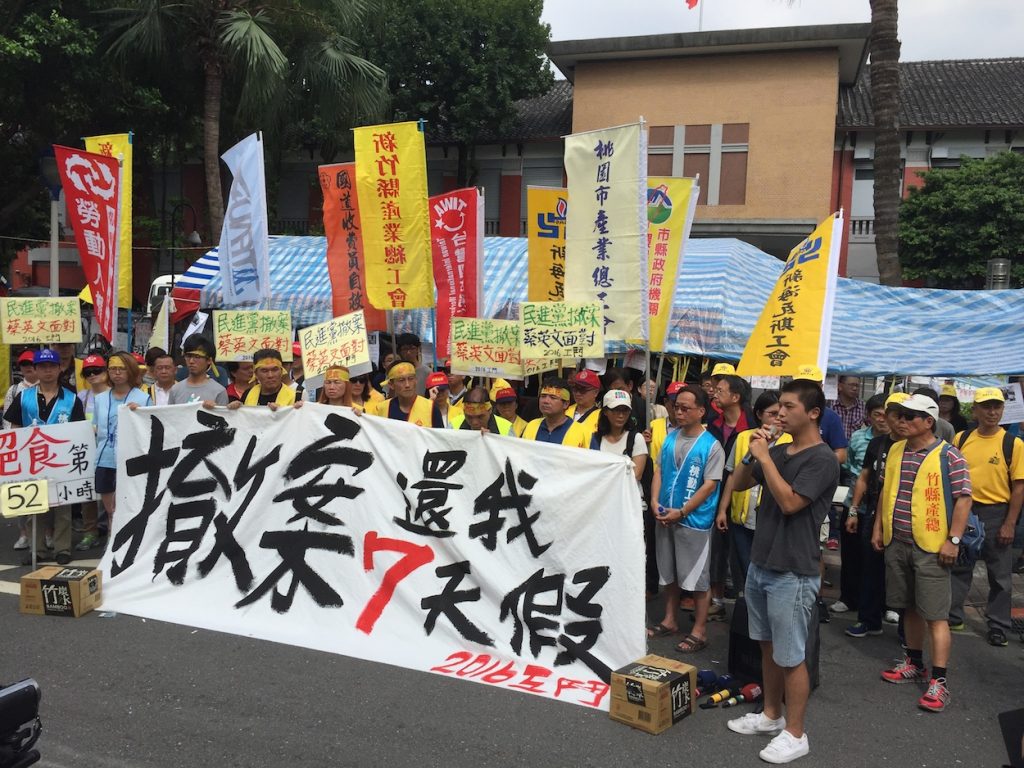 Workers demonstrating against planned cuts in public holidays. Photo credit: Brian Hioe
Workers demonstrating against planned cuts in public holidays. Photo credit: Brian Hioe
In addition, the Tsai government plans to convene a national conference on judicial reform in the next few months. Taiwan’s Minister of Culture Cheng Li-chun (鄭麗君) is also hoping to convene a national conference on culture. Tsai has promised to find a credible “civil opinion leader” to be the deputy convener for the preparatory committee for the national affairs conference on judicial reform. On this issue, Tsai has made progress in incorporating the views of the public into her decision-making. But if Tsai wants genuine civic participation, I’m afraid some adjustments need to be made.
Otherwise, these kinds of conferences will be nothing more than the ones held during the Ma Ying-jeou (馬英九) administration, such as the national affairs conference on economics and trade, or the national affairs conference on energy. These two conferences degenerated into trifling speaking engagements for all participants involved. In the end, a pile of “conference findings” were produced, and plopped on some public official’s desk for consideration. It’s hard to imagine any kind of direction on the economy or energy could be found from these kinds of conferences.
In part, the Ma government was willing to try out these instances of civic participation because the Sunflower Movement had broken out the same year. There was some success to be found, and there were some failures too. What could the Tsai government learn from this experience?
The Repercussions of the Sunflower Movement on the National Affairs Conference on Economics and Trade
ON THE EVENING of March 17th, 2014, many people charged into Taiwan’s Legislative Yuan to protest the Ma government’s decision to attempt the forced passing of the Cross-Strait Service-in-Trade Agreement (CSSTA). The demands put forward by the protesters included a request for Ma to immediately convene a conference on civic and constitutional governance. But Ma believed that the CSSTA was an economic issue, and in July 2014, conduct a national affairs conference on the economy and trade instead.
Because Sunflower Movement protesters were adept at using internet technology, Ma’s decision to use a netizen participation mechanism at the conference attracted a lot of people’s attention. Not only were a few internet opinion leaders invited to participate in the conference, there was also a simultaneous live video feed of the conference, along with on-the-spot discussion of the conference being projected at the assembly hall.
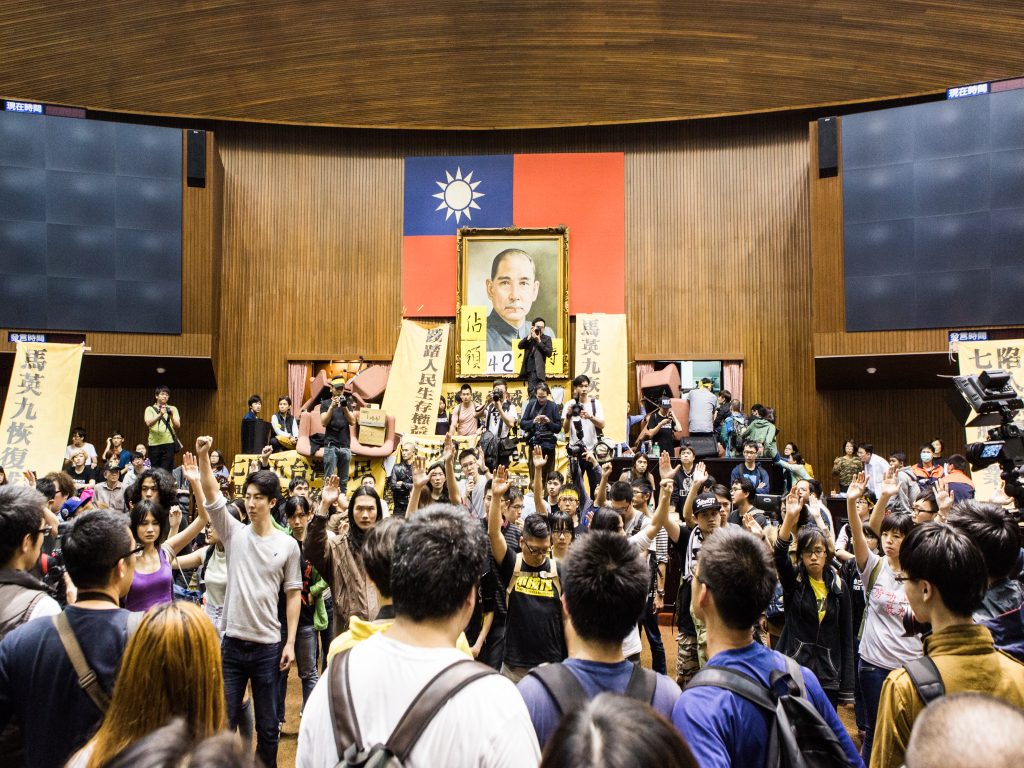 The occupied Legislative Yuan during the Sunflower movement. Photo credit: Democracy at 4 AM
The occupied Legislative Yuan during the Sunflower movement. Photo credit: Democracy at 4 AM
Shortly after taking part in the event, Albert Tzeng (曾柏文) wrote in an essay titled: “Who was actually being represented at the national affairs conference on the economy and trade?” Tzeng pointed out that the scope of the conference was confined by the government’s authority to determine the topic of the conference, the guest list, and even the way the conference findings were written.
But the conference structure should be no surprise. When the government formulated policy in the past, they would generally invite members of industry or academia to participate, completely lacking any channels for the public to express their opinions. In the end, these policies are often excessively inclined to only affect private capital, bring about persistent differences of opinion, and puts an angry public on the outside looking in. This leads to protest, and is a massive cost to civil society.
The First Signs of On-Line Civic Participation: The Join Platform and vTaiwan
BUT THE NATIONAL affairs conference on the economy and trade had one encouraging development. During the conference, a number of people suggested the establishment of a website similar to the US White House We The People platform. By submitting a motion on the platform, and then receiving a number of co-signatures, one can receive a response from the government within a fixed time limit. Afterwards, Taiwan’s National Development Council (NDC) established JOIN—a public policy internet participation platform. With its establishment, the JOIN platform allowed people to pro-actively propose ideas, then petition support from co-signers. The platform also allows the government to inquire opinions from netizens using the “People Start Speaking” feature.
In addition, a member of the Executive Yuan’s state administrative council proposed a project to the Taiwanese open-source social community “g0v”. Then-Minister Jaclyn Tsai (蔡玉玲) was in charge of adjusting laws and regulations regarding the virtual world, and hoped to set up a mechanism that would listen to, and collect public opinions from netizens. With the help of g0v participants like Audrey Tang (唐鳳) among others, Tsai was able to establish the vTaiwan platform, and carry out a good deal of opinion polling on controversial policy issues.
 vTaiwan logo. Photo credit: vTaiwan
vTaiwan logo. Photo credit: vTaiwan
Since the establishment of the vTaiwan platform, the Executive Yuan has been able to open a discussion with netizens about policy formulation regarding the virtual world. With the g0v community acting as a mediator to coordinate with netizens on a given issue, the opinions and demands of various stakeholders can be summarized, and the point of contention can be discovered quicker. If there is a need for a minister to reply to a question, the minister must reply within seven days. After the working group collects all the suggestions, a meeting can be convened with all stakeholders invited. The minister in question and a netizen spokesperson participate in the meeting. The meeting is also recorded and broadcast online through a live video feed, and subtitles relayed.
But JOIN and vTaiwan still have a great deal of limitations. The proposal submission mechanism on JOIN is missing a function that allows questions to be clarified. In addition, the comment function on the “People Start Speaking” is weak, and it is hard to focus on providing good suggestions. As for vTaiwan, the government needs to take the initiative in order to submit a proposal on the platform. If there’s a minister that isn’t willing to cooperate, it’s difficult to find a channel for the public to table suggestions, or establish discussion.
About: “g0v”
THE ORIGIN of g0v can be traced back to the end of 2012, when a group of socially-conscious Taiwanese information engineers were dissatisfied with a pandering television ad campaign that dumbed down the Executive Yuan’s new economic plan. In a span of three days, they completed a data visualization of Taiwan’s entire annual budget. Gradually, a group that believes in the spirit of open source, freedom of speech and is devoted to promoting transparency began to take form.
The group replaced the ‘o’ in gov with a zero to signify it’s wish to consider the role of government from zero on up, and also represent the new digital age where things are viewed in terms of 1s and 0s. g0v is pronounced “Gov Zero.”
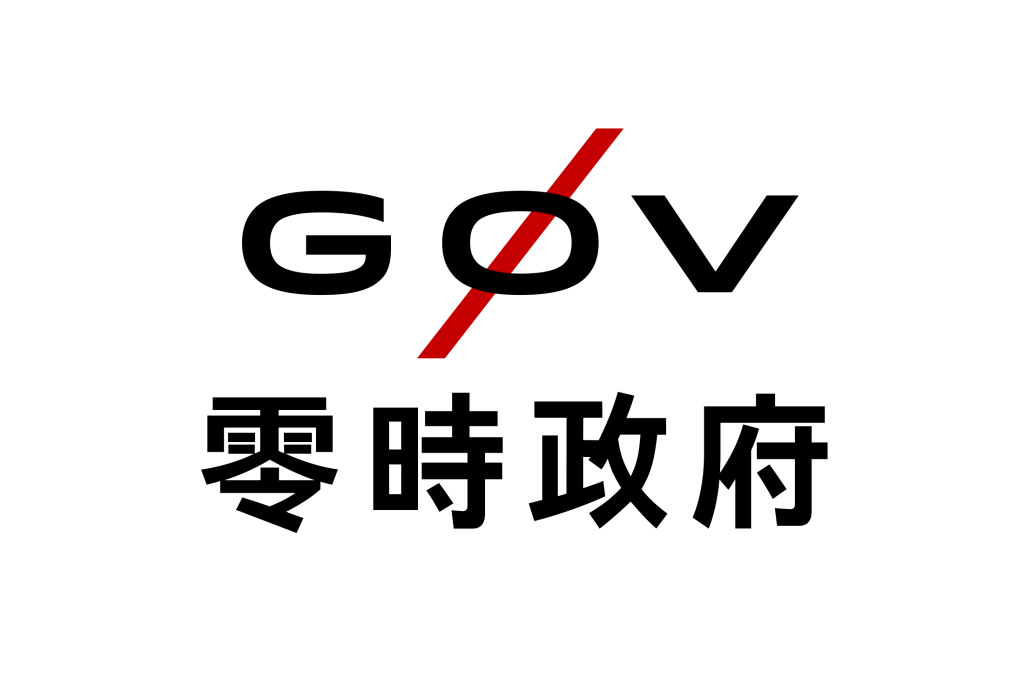 g0v logo. Photo credit: g0v
g0v logo. Photo credit: g0v
All kinds of citizens participate in g0v: engineers, designers, government employees, members of the media, NGO workers, and so on. Anyone can put forward a proposal, and of one’s own accord, participate in the proposals of others. Some of the most famous proposals include: An online Mandarin-Taiwanese-Hakka language dictionary, a crowd-sourced political contribution digital index, the Appendectomy Project, among others.
[Compiled by Initium editors from the introduction page on g0v’s website]
Ko Wen-je’s “Open Government” Reality Check
ANOTHER POST-SUNFLOWER Movement political change has been the election of political novice Ko Wen-je, whose lofty idea of “spotless power” (白色力量) has stressed transparency, and participation. Before being elected, Ko promised he would try using “civic deliberation” in dealing with a number of controversial policies.
At the time, there was already a number of successful cases in which local governments used public deliberations to resolve disputes, such as the the 2014 Tainan City Feiyan New Village (飛雁新村) case. It appears that civic participation in the early stages of the policy process is able to resolve a number of controversies. But the question is: How does civic participation conform to the existing policy process? How do public officials and policy-makers view civic participation?
The controversy that erupted over the proposed relocation of the historic Mitsui Warehouse (三井倉庫) at Beimen is an example of this problem. From this case we can see that civic participation procedures were nominally added, but an attempt by the government to forcefully guide public opinion turned its civic participation into a hollow facsimile. The city administration might adopt such a mechanism because it believes that “the people will stand with me on this issue”, and hopes to use “the will of the people” to force through its opinion. But this so-called “civic participation” is unable to cast off its singular mentality of steering policy.
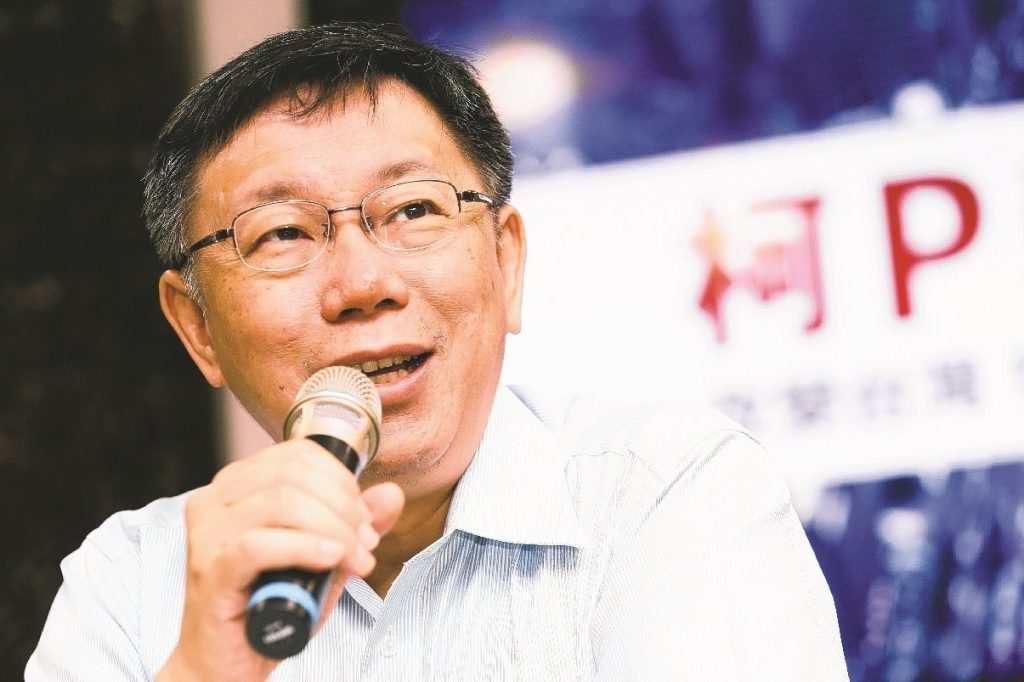 Taipei mayor Ko Wen-Je. Photo credit: WikiCommons
Taipei mayor Ko Wen-Je. Photo credit: WikiCommons
This way of doing things gradually leads to participants being dissatisfied. For example, when the Taoyuan Aerotropolis Plan was being discussed on the JOIN platform, officials dodged inquiries and disputes from residents who protested the plan. Questions like: “What kind of Taoyuan Airport Terminal 3 would you like to see?”, were met with criticism because the question already embodied a specific viewpoint, and attempted to guide the discussion to the government’s liking. This triggered widespread discontent from netizens.
After all, people participate in these meetings because they want their views to be heard and considered. If the government already has their set view, it doesn’t matter what kind of citizen participation forum you run, in the end, it will become a total disaster. In cases where the government has tried to persuade the public by providing biased background information, or a one-sided opinion, only to be exposed later as being false, it inevitably leads to the government’s credibility collapsing. Even if that government previously participated in civic participation activities, their accumulated credibility plummets to zero.
From Guiding the Policy Discussion to Genuine Communication
IN THE PAST, the public was only able to use television and newspapers to obtain information about policy. Many government officials often assumed that the public wasn’t clear about policy details, and intuitively labeled their opinions as “populist”. But in the present day where the internet is universal and bandwidth speeds have exploded, many professionals in their respective fields share their knowledge online, and even question the expertise of public policy. If the government continues to intuitively label the public’s opinion as “populist”, then there will be a great deal of people dissatisfied with the government.
In my opinion, the most important thing for the government to remember when dealing with civic participation is: readjust your way of thinking.
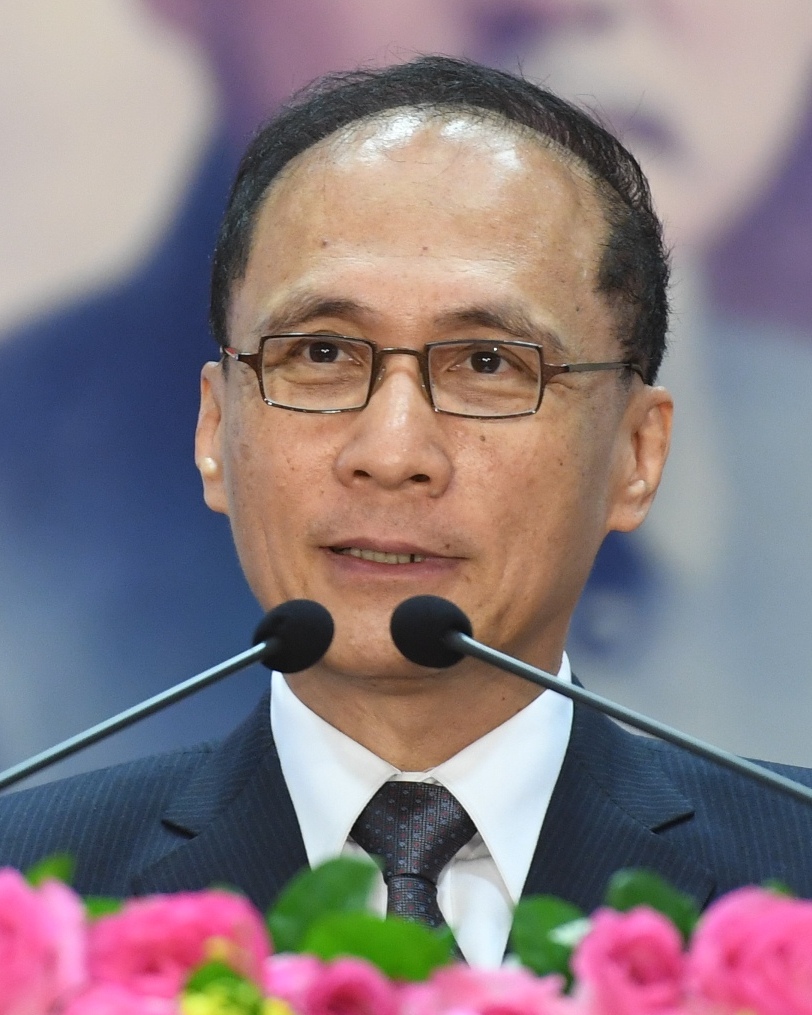 Premier Lin Chuan. Photo credit: WikiCommons
Premier Lin Chuan. Photo credit: WikiCommons
Government officials should set aside their own position. Instead of taking a position like “The public will support me” or “I need to persuade the public to support me,” it should turn into “we tried our best, but there might be something we missed. We hope the public can help us find the solution to the problem.” The government should then invite the public to offer their views, or even combine efforts. With their way of thinking readjusted, the first line of public officials are more able to face the public’s questions in an unperturbed manner. As soon as public officials set aside their self-imagined roles as “mother hen” figures in civic participation forums, and begin to honestly disclose the limits and realities of their situation, then they are finally able to obtain the public’s trust, and can allow for policy implementation closer to the public’s demands.
That is the true spirit of democracy. It isn’t about trusting one person or a group of people. It’s believing that people almost certainly have blind spots, and certainly make mistakes. Consequently, through freedom of expression, we are able to discuss issues together. Through public institutions, a solution can be found that will make everyone more or less satisfied. Of course this process takes time, but compared to acting arbitrarily on policy making which inevitably leads to disputes and igniting large scale societal conflict, the net cost is certainly worth it.
Setting Up a Mechanism that Accounts for Responsibility and Pushes for Civic Participation
WITH A TRANSFORMED way of thinking, we discover that there a number of things that can be changed.
In the past, the public had few channels to obtain information or participate in policy discussion, and it was more difficult to provide informed ideas. But with unimpeded channels for participation, and data releases in a condition where privacy is not invaded, the public can consider data regarding policy decisions, or, members of the public with expertise in a given field could use their talents to help find problems the government has overlooked.
The focus for this kind of meeting should be “consultation” not “policy making”. Consequently, “diversity” and “inclusiveness” are more important than “representativeness.” At the same time, since the essence of the meeting is consultation, the meeting’s conclusion should provide a series of recommendations for the government to consider. The government doesn’t necessarily have to accept the recommendations. But supposing the government refuses, then there should be a person who comes forward to shoulder the political responsibility, and explain specifically why the suggestions were not adopted.
When writing policy proposals, they should also reveal a variety of policy alternatives that may be necessary based on possible restrictions of limitations encountered. These steps put officials more in touch with the people, and help participants have enough information about the issue. Even more, participants could work together to establish the agenda and discussion topics to enlarge the space for participation. Through these efforts, the government can move from the ballyhooed push for “open data” to the next development: “Open governance.”
It’s a unfortunate that many government and public officials imagine civic participation as simply meaning “using more tech”. Whenever civic participation is discussed, they think immediately about things like live-streaming, typed-up meeting transcripts, ivoting, public coffee gatherings, etc. They forget to examine the entire policy process from the beginning, and forget the core spirit of integrating public opinion. During these meetings, they don’t even try to clear up where the dispute lies, which derails the entire project. This is merely a surface-level civic participation; it’s frustrating for hard-working public officials, and causes the public to distrust the government.
From Open Data to Open Governance
THE CURRENT CONDITION of the Taiwanese government’s civic participation is based on whatever the Ministry head feels like doing.
Some successful cases include the Ministry of Health and Welfare’s excellent communication on long-term care policy. The ministry also successfully used the JOIN platform to draft a proposal regarding immunotherapy. As for the controversy over the “one fixed day off, one flexible rest day” policy, as long as the Ministry of Labor maintains a neutral, open and transparent position, it would allow for both laborers and employer groups a chance to sit down and talk, and both sides would avoid a difficult decision where each side is blamed for whatever it does.
On the other hand, civic participation needs to watch for various kinds of readjustment. The differences between each ministry is huge and these experiences lack a horizontal exchange channel. The Taiwan government could consider the experience of France’s National Commission on Public Debate (Commission nationale du débat public, or the CNDP) in which the government and the public established a group that is responsible for civic participation. This group assists government offices in creating a systemized civic participation mechanism, and embeds it in the existing policy formulation processes. This may lead to Taiwan’s civic participation system becoming more mature.
 Audrey Tang. Photo credit: Audrey Tang
Audrey Tang. Photo credit: Audrey Tang
The biggest development to look forward to has been Premier Lin Chuan’s (林全) recent announcement that he has recruited long-term g0v participant Audrey Tang to enter his cabinet as a minister without portfolio. During Ma Ying-jeou’s term in office, Audrey worked as an advisor to then-Minister Jaclyn Tsai, and has experience communicating with a number of ministries.
But if the government wants to facilitate civic participation, then it needs genuine communication. Only then can it become the government “most able to communicate”.

